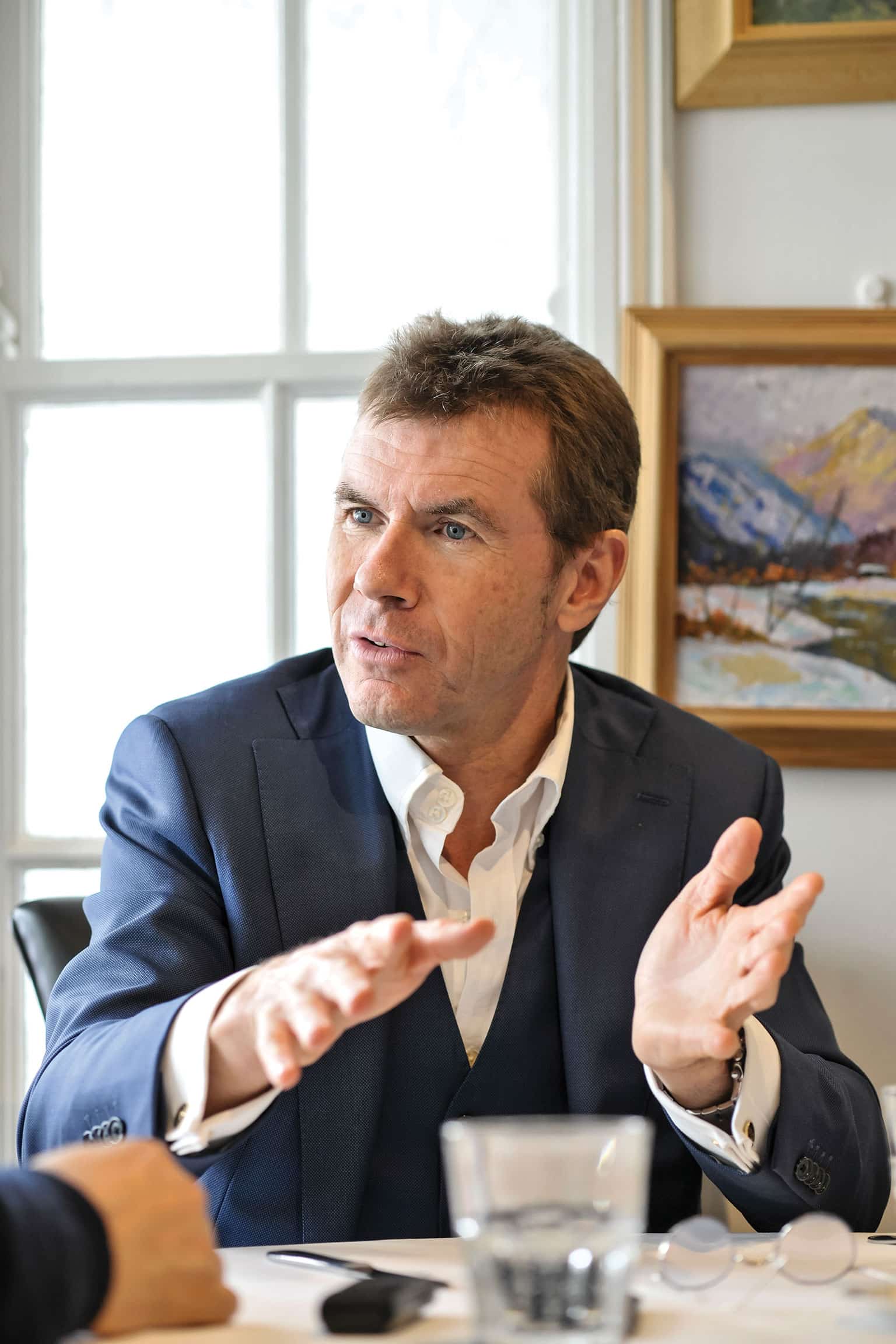Lunch with Paul Stewart
Driver, team owner and son of a famous father, Paul Stewart quit the sport in his prime. He tells us what he learnt along the way and why he has no regrets
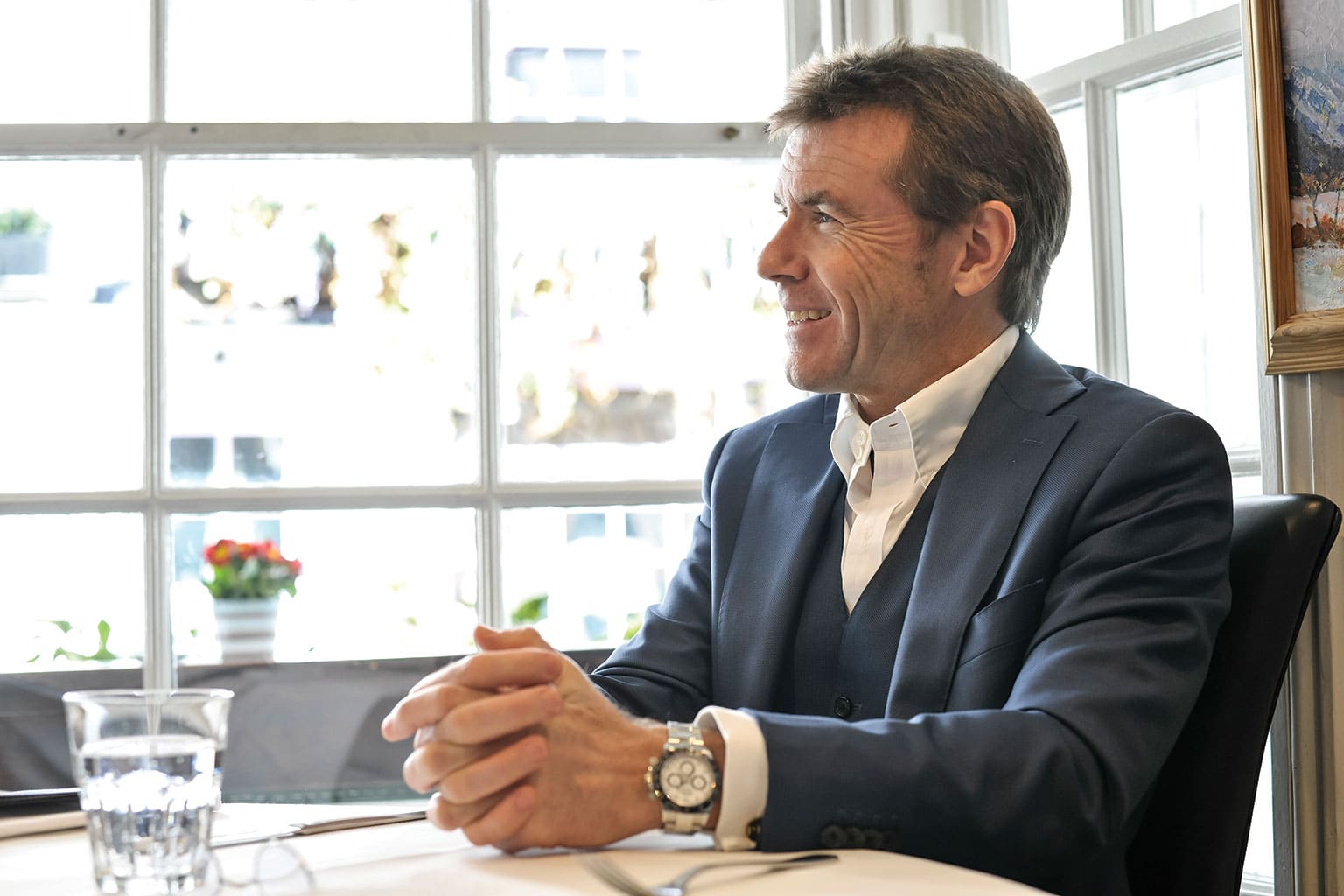
Stuart Collins
I first met Paul Stewart in March, 2000. We were both attending the Australian Grand Prix, me in my usual capacity of hack, him as chief operating officer for the newly formed Jaguar Racing team. I know we spoke but looking back over the notes I took, I see barely any quotes from him. I recall instead a restless, brooding figure, understandably with better things to do than chat, visibly bearing the strain of Jaguar’s return to racing. His stress levels will not have been helped by the fact the company appeared to have bought every billboard in Melbourne to pronounce ‘The Cat is Back.’ In the event as the weekend from hell unfolded, with his cars lacking both pace and reliability and suffering the ignominy of being the first two to retire from the race, he probably ended up wishing he had stayed at home in Milton Keynes.
But it was about to get a whole lot worse: three races into the season he was sufficiently unwell to need hospital treatment. Tests confirmed the worst: aged just 34, former racing driver Paul Stewart, a son, husband and father of young boys, had cancer. He left the world of racing at once to focus on surviving non-Hodgkin lymphoma, and has not been back since.
What a difference 17 years away from the sport can make. Today Paul Stewart strides into the Villa Bianca Italian Restaurant in Hampstead, immaculate in a blue three-piece suit and apologising for being late (which he isn’t). Despite a busy schedule he is supremely relaxed, happy to spend an afternoon talking about events that stopped half his adulthood ago. Now aged 51, he is clearly fit and well and enjoying himself in a way that simply was not possible in his racing days.
We’ve met a few times over the intervening years, usually at old car events where Paul can sometimes be tempted back behind the wheel of some priceless exotic, but only for gentle demonstration purposes. This man who progressed from Formula Ford to F3000 and a number of serious F1 tests with an established team today drives racing cars only for recreational purposes. “I’m not interested in racing, even in historics. I’ve had many offers and I’ll happily drive around a circuit, but I don’t want to go off in a car that’s going to fold up around me. When I was racing, if flat through Eau Rouge in an F3000 car was what was required, that’s what I’d do. But to put it all on the line for anything other than your life’s mission doesn’t inspire me at all. I have huge respect for people who go racing at Goodwood and elsewhere, but it’s not for me. The stories you hear, like Dario Franchitti and Adrian Newey waking up next to each other in hospital? No thanks.”
Stewart does not bother to look at the menu but orders carrot and orange soup followed by sea bream with mashed potato and fried zucchini from the list of specials. He is poured a glass of fizzy water as the tape begins to turn.
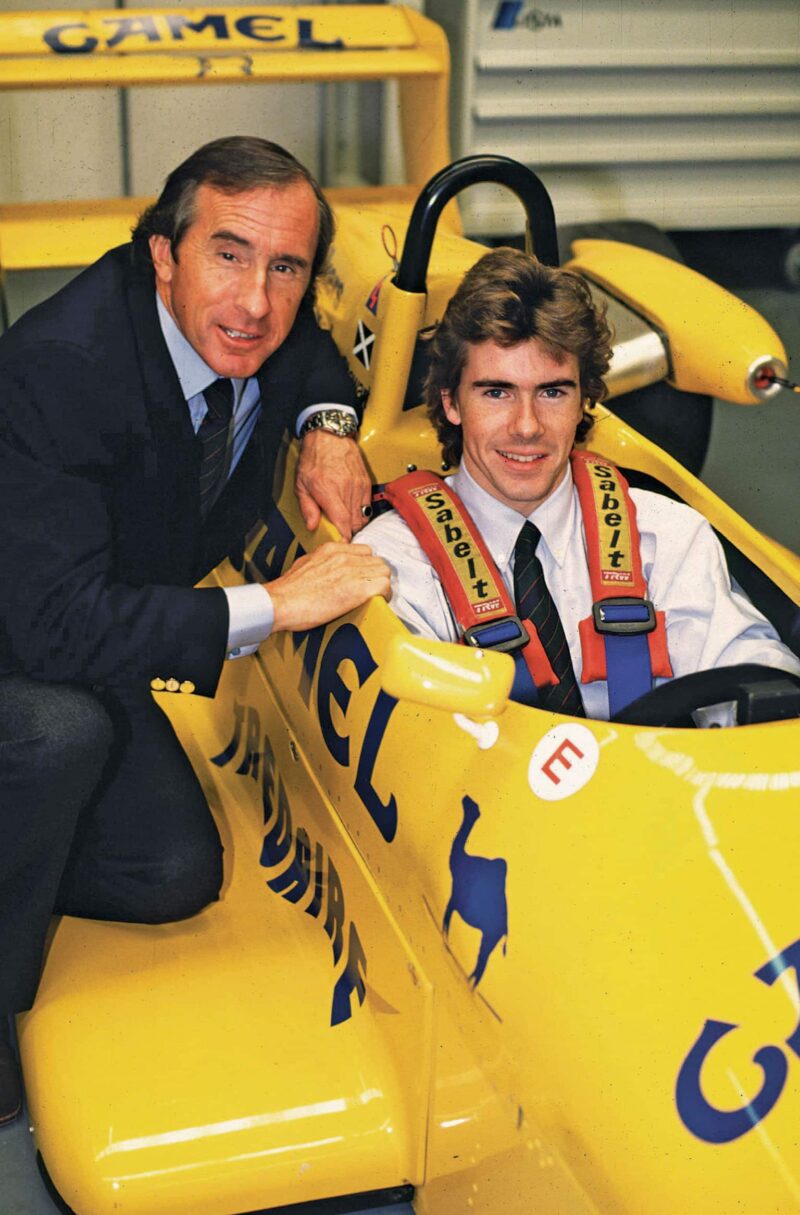
Stewart graduated to Formula 3 after a swift apprenticeship in FF1600 and FF2000
Motorsport Images
Paul Stewart was born on October 29 1965, five days after his father Jackie retired his BRM P261 from the Mexican Grand Prix to conclude his first year as a driver in Formula 1 and, indeed, a winner in F1, courtesy of victory at Monza in his rookie season. Paul grew up in Switzerland with his brother Mark, unaware at first that theirs was not a normal life.
“It was a very happy childhood. I was born in Scotland but moved to Switzerland before I was three and lived near many other racing drivers. Jochen Rindt’s home was literally two minutes away, Jo Bonnier was up the road. It seemed completely normal to me because they were just my parents’ mates. Odd things I do recall, like Roger Penske teaching me how to shake hands. I shook his hand but didn’t look at him; I remember him saying, ‘When you shake hands you have a firm shake and you always look ’em in the eye.’ And that must have had an impact, because I was quite small and
I remember it to this day.
“I first started to realise things were a little different one day when Sean Connery came to pick me up from school with my mother. To me he was just someone who was staying with us, but I did notice it caused something of a commotion among the other mothers… In time it was also pretty clear that older boys at school were paying attention to me when they’d not normally have given the time of day to someone so young.
“I learned to drive sitting on my father’s knee, steering cars up and down the drive, but when I was a little older, and I still mean only about 12, I’d take the cars when my parents were out for dinner. I remember my father had a Ford Granada, and I’d put a cushion behind me and take a friend driving. It sounds like I was mad, but the car was automatic and he was two year older than me and bit more sensible too – if I’d gone by myself I’d probably have ended up in serious trouble, but he watched my back. And I wasn’t just crawling about, I’d get out there and overtake other cars. Which is why I always hide the keys from my boys today…”
But there was another side to this life, one from which no child of a racing driver could escape at that time. “My memories as a child are mainly of drivers getting killed. They were my father’s friends, and these events marked me. I was only five but I was at Brands Hatch in 1971 and remember it with crystal clarity, seeing the black smoke rising from where Jo Siffert had had his accident.
“Jo Bonnier’s kids Kim and Jonas used to go to school on the same bus as me. It was a small bus. In 1972 their father was killed at Le Mans and they said to me ‘Your dad is going to be next.’ They weren’t trying to be cruel, it was just obvious to them. Natasha Rindt was with us as well and her father had already been killed. It culminated at the end of ’73 when I was told my father had been killed at Watkins Glen. Of course it turned out to be François Cevert, but you can imagine what being told that was like.” At the age of seven? Happily for me, I can’t.

Jan Magnussen starred for PSR in 1994
Motorsport Images
Not that it dampened young master Stewart’s love of cars. “I loved them since my earliest memories. When I was really little and my father was racing for Matra, they sent us a toy car that you’d drive by sitting on the rear wing and pedalling. But I got the pedals removed as soon as I discovered that if you went downhill as fast as possible the pedals would revolve so fast they’d take your ankles out.
“But I never thought I’d be a racing driver, because of all those drivers, those friends, who’d got killed. Besides, my parents were totally resistant to it and when I finally decided it was a path I had to explore it was like pushing water uphill.”
At the time he was 17 years old and living in a country where motor racing had been banned since the Le Mans accident in 1955. “The odd hillclimb aside, there was no motor sport. Like everyone else, I grew up skiing, so I never had the chance to do karting as a kid, and grow up with the experience of those I’d later race against; besides, my father was dead against it. But I was always highly competitive as a child, so I plucked up the courage to tell him I wanted to try to become a racing driver and that I’d lined up to go to Jim Russell at Snetterton. I’d got all the prices and flight costs and was going to pay for it. His reply was simply, ‘If you do it, you’re on your own,’ and he showed me a book about Siffert saying ‘Look, here’s another one.’ But we talked some more, he could see how determined I was and eventually said ‘If you go to university and work hard I will at least look at helping you’.”
So Stewart went to read political science at Duke University in North Carolina, dutifully working in financial institutions in New York and Switzerland during the holidays until the summer when he would graduate. “And I got this overwhelming feeling I had to try racing now, that I’d never get a better opportunity to see if I could do it.”
He had already done a driving course, but only because Jackie thought he ought to learn about car control to be safe on the road, so he signed up to a racing school at Brands Hatch under the name of Robin Congdon to make sure he got an honest assessment, paid for it himself and headed to Kent to find out if he was, indeed, a chip off the old block.
“It went well. I found this out because Stirling Moss had been there so I had to hide from him and afterwards I rang him up to apologise and he told me the organisers had been talking about this American kid who’d been going really fast…”
“I went back to my father and said I wanted to go racing and while he still didn’t like the idea at all, he figured that if he didn’t help I’d just go elsewhere and he didn’t want others involved in his son’s career. So we started working together, and I’m very grateful to him for that. And that led to Paul Stewart Racing and, ultimately, Stewart Grand Prix.”
The young Stewart duly signed up to do Junior Formula Ford 1600 in the summer of 1987 and, while he didn’t win anything, he led some races and had some second places. Given he was a complete rookie, up against drivers with eight seasons of competitive motor sport already under their belts, he thought he’d done well enough. “And I decided that was it. I wanted to do it. Decision made.”
When I ask how much the Stewart name helped in the early part of his career, Paul spares me the bluster you hear from other children of famous parents who pretend it’s been more of a hindrance. “Having the Stewart name has been a huge privilege. I never underestimated the privilege that came with it, never tried to say it didn’t make a difference, never tried to deny there were any number of other drivers who would give their right arms to be in my position. There’s that whole business of living in the shadow of my father but I’m proud of my life, proud of the decisions I’ve made, proud of my father and what we’ve all done as a family.”
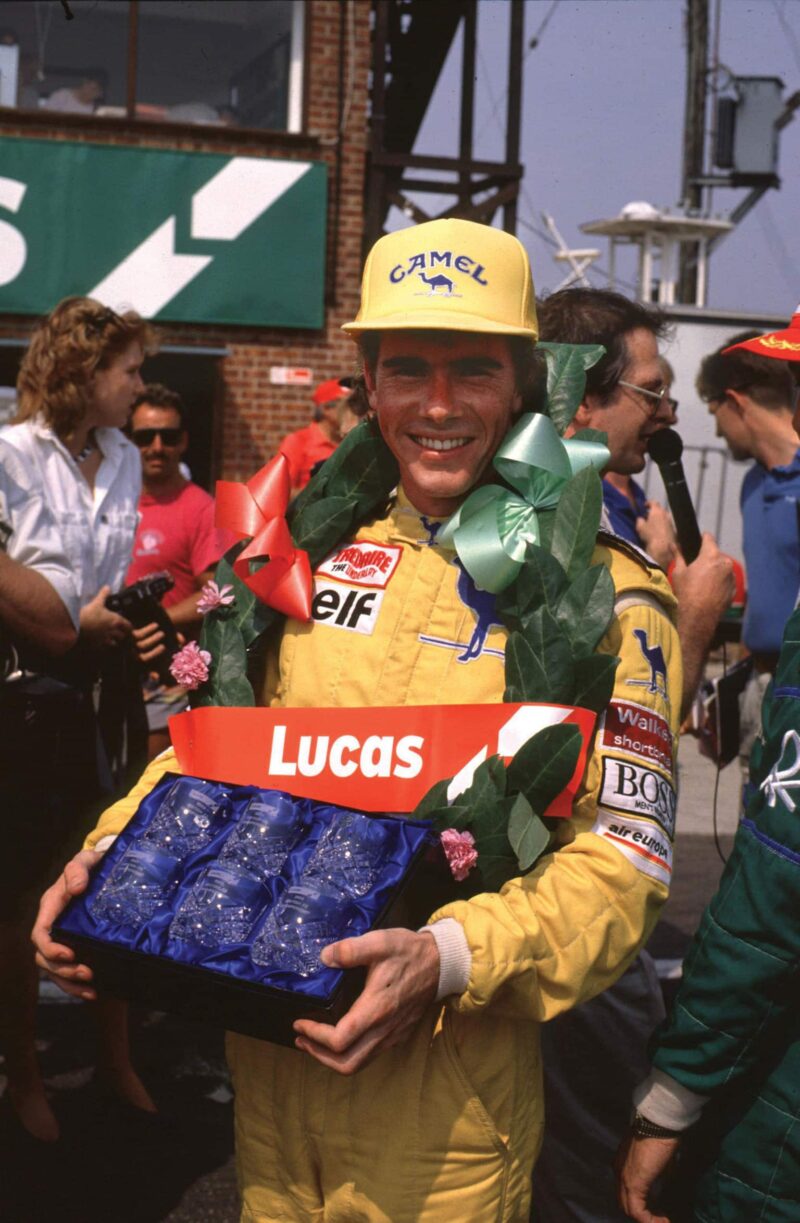
Celebrating F3 success at Snetterton
Motorsport Images
So Paul Stewart Racing came into existence in 1988, fielding a FF2000 sporting Camel sponsorship that effectively paid for the team to be set up. “We investigated other teams and the cost of going racing with them instead – we took a long look at Keith Wiggins at Pacific, whom I respected enormously – but I knew if I went down that road I’d be coming in as the guy bringing the budget and I didn’t want to be that person.
“Reynard gave us the assurance that starting our own team could be done and my father found Roy Topp, one of his original mechanics, and we just got on with it.” For someone with his lack of experience he did well, but aware he was starting late needed to progress up the ladder at speed. “The 100 per cent aim was to become a successful Formula 1 driver. I had the team and for such a new business it was doing well, but my focus was on getting to F1.”
But first he had to get to F3. “We had Graham Lewis, a former chief mechanic from Brabham, working with us and he’d said that if I won one race, I’d get the budget to do F3. But he had problems elsewhere in his life and tragically he committed suicide. That really shook me, but I won the next race at Cadwell Park and we got the budget. He’d been right.”
In Formula 3, Stewart came up against people who’d go on to become among the best in the world: Mika Häkkinen, David Coulthard, Gil de Ferran and Kenny Bräck. “You will only do your best if you’re competing against the best and if by being with the best they could help me get to Formula 1, that was just fine.”
But none of them was also running the race team for which they were driving, a fact Paul could add to his lack of race experience to explain why he never established himself as a consistent front-runner. But he doesn’t. “I won’t deny that splitting my time between running Paul Stewart Racing and driving for Paul Stewart Racing was tough: I could find myself presenting to potential sponsors, doing a full day’s testing at some far-flung circuit and driving the van to and from Stockbridge all in a single day. If I’d been able to channel all my energy into driving maybe it would have turned out differently. Or maybe it wouldn’t. I was old when I started driving. And you can see it a completely different way and say we were incredibly lucky, mainly because with most small teams in the early days chasing the money is the most important part of the business because without that there is no business. But with Camel and our other sponsors we were pretty well covered in that respect. I have no complaints or regrets at all. Not once have I ever thought ‘if only’.”
Besides he was no makeweight and won at Snetterton in highly unorthodox circumstances. “I was leading, came up against a backmarker who looked like he was going to move one way as we were going into Russell, back when it was a proper, flat-out corner. In fact he went the other way. I spun and crossed the line backwards but the race was then red-flagged because Mika Hakkinen had just had a huge accident at the Bombhole and I won it on countback.” To give an idea of how competitive F3 was in those days, that day at Snetterton, the first 15 places on the grid were covered by less than a single second.
That win earned him a place on the grid at the Macau Grand Prix where he qualified third and earned the title of best newcomer. “Frankly, I was lucky to there and totally out of my depth.” Even so he found himself in the lead being followed closely by a young hotshot driver. “I came to this corner where you cannot overtake, so took a wide line to get the best exit onto the straight. And, boom, up the inside comes this car. I couldn’t believe it. And that was my first insight into what kind of driver Michael Schumacher would become.” And, yes, Michael made the move stick.
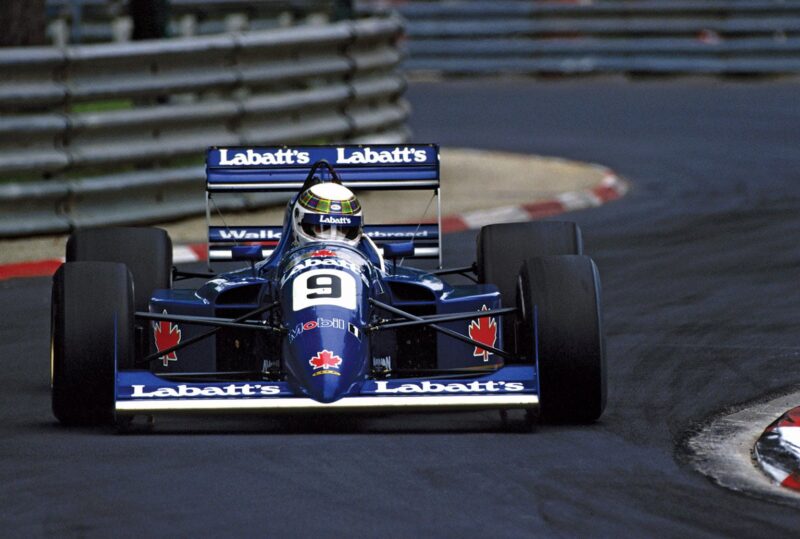
Tackling the tricky Foch chicane at Pau in 1991
Motorsport Images
But if Stewart the driver was feeling a little overwhelmed, Stewart the race team owner was going from strength to strength. “I figured out fairly quickly that if you bought a good car from Reynard or Lola then it was just a question of hiring the right people to run them and that was something I could do.
“I was never afraid of hiring people with more experience or who were older than me. We hired good people, helped by the fact that they knew if they came to us they were going to get paid, which is not always a given with smaller teams struggling to put a budget together. I learned from these people. We weren’t flush with cash and I always ran a tight operation, but we had enough to get the right people like Andy Miller on board. When we got to F3 and F3000 he would run the team which meant I could try to focus on being a driver. And I’d take instructions from him like any other driver. I never played the ‘I’m the boss’ card. And I don’t take credit for the success – Paul Stewart Racing takes it, which is a very different thing. If I did anything smart it was just recognising that we had to hire good people. Without them, we’d have achieved nothing.”
By the end of 1989, two seasons after Paul Stewart became a full-time racing driver, he had an F3 team, an FF2000 team and a Formula Vauxhall team and needed new premises, which he found in Milton Keynes, partly because it was close to his home in Woburn but mainly because the new town was desperate to attract business and space cost approximately half of what it did further south.
The next step for both team and driver was Formula 3000. “It was a bit of a shock to be honest. You look at the times and you convince yourself it’s like an overpowered F3 car with a bit more aero, but then you get in there and it’s a completely different level. I can remember the first test in a Lola, sitting there with all that noise, head exposed, shoulders almost outside the car and thinking that if something goes wrong you’re in a completely different ballgame to F3. You’re going to have a proper shunt.”
Stewart did three seasons of F3000 with Marco Apicella, Coulthard and de Ferran as his team-mates, and reached a crossroads in his career. “I’d done three years, not won a race [though he did come third at Pau in ’93 in the last contemporary single-seater race to be won by a DFV-powered car], and thought ‘What gives me a reason to think I’m going to make it into F1?’” So despite testing for Footwork and much to the relief of his father, he just stopped.
Instead he poured his efforts into running the team: Paul Stewart Racing won 13 championships, including the British Formula 3 championship six times in seven years between 1992-98. But ultimately the call of the top tier became irresistible.
“We’d looked at all options from touring cars to Indycars but Ford was unhappy with its F1 programme with Sauber and there was a chance for us to put a proposal together.” The deal was signed just before Christmas in 1995 and on December 10, less than a year later, the Stewart-Ford SF01 ran in public for the first time. “It was nerve-wracking to have your own F1 team. I remember arriving in Australia, looking out of the plane window and realising I was manifesting a dream: that all these people were coming out here to help make real something that had started in my mind. The challenge was utterly daunting but there was no emotion beyond that; we just had to get the job done and not look foolish. The first time I sat back and thought I’ve got to take a moment to take this all in was during qualifying at Monaco in ’97. We had the two cars there, the sun was shining, I looked up at the palace and thought ‘This is just unreal.’ I paused for one moment, then got back to work.”
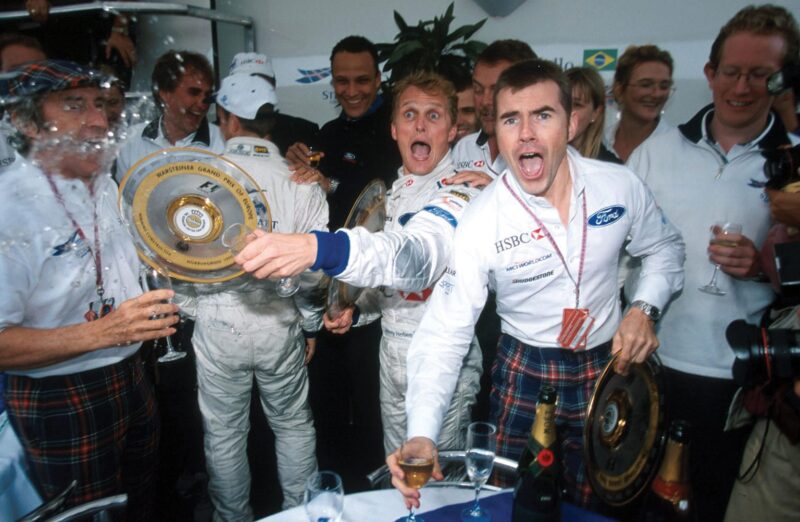
The aftermath of Johnny Herbert’s European GP win in 1999
Motorsport Images
That first season was dogged by reliability issues and an underpowered Ford engine, but just once those two great levellers, Monaco and rain, allowed the team’s new driver, Rubens Barrichello, to really show what could be done. “At the start others had weather forecast helicopters that said the rain would pass and went for slicks but we just looked out of the window, said ‘It’s raining’ and used wets. It was the right call. Rubens kept out of trouble, passed a few cars, watched a few cars drop out and we were heading for second when his hydraulic pressure started to fall. Our analysis said there was no way he’d make it and I was chewing my nails to the bone thinking ‘Please, please get across the line.’ Really it was a miracle that he did. My father and I got very emotional, all I could do was hold his head. After all we’d been through, it was a moment never to forget.”
But those six points were all the team would score that season, which was one more than it would score in 1998. “Alan Jenkins designed a good car for 1997 but the engine wasn’t reliable. The next year Cosworth gave us a good engine but we had to adapt to huge rule changes in just our second year and as a result the car was poor. But then we pulled it together in 1999, hired some good guys and got Gary Anderson on board during the season.” Finally Stewart Grand Prix felt able to compete.
And compete it did, and if Johnny Herbert winning the European Grand Prix at the Nürburgring could be called lucky by some (including Paul) there was no need to qualify the results at the end of the season: fourth place in the championship ahead of Williams and Benetton, and even a pole position for Rubens in France.
It was sufficient to ensure that when Ford wanted to enter Formula 1 as a full factory team under the name of its Jaguar brand, it was Stewart to whom it turned first.
“I never saw it as us losing a team. It was a conscious decision. Ford came to us and if we’d said no, it would have carried on because Jac Nasser wanted Jaguar to be Britain’s answer to Ferrari. They’d have been nice to us but we’d have become a customer team while they went and did a deal with someone like Prost or Flavio. We’d have always been second-best.
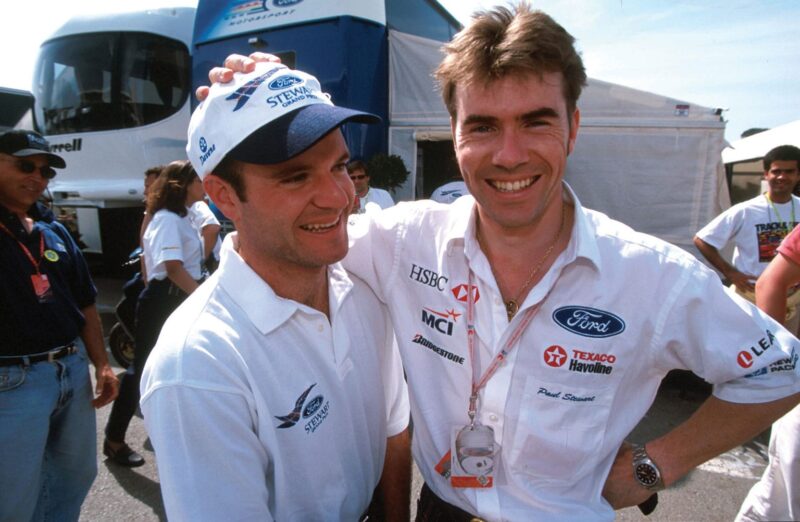
Rubens Barrichello was the team’s first F1 recruit in 1998
Motorsport Images
“I had no pangs about my name no longer being in it. I always knew how fragile this business inherently was – the loss of just one client and that could have been it. We weren’t for sale, so when Ford offered to buy the company we were in a position of strength and while it was never part of the plan, it was something that was going to make quite a big difference to my life and I was smart enough to realise such opportunities don’t come along that often”.
According to Jackie, Ford paid $130m for the team. “They wanted me to keep on running the team, which I was happy to do because the dream was to end up doing what Red Bull is doing today from the same premises having bought the team from Ford. And I was part of that transition. But then I got ill.”
Understandably Stewart doesn’t want to dwell for long on the disaster that Jaguar Racing became after he left, but puts it down chiefly to the team failing to hang onto key people. “I understood the value of their contribution and had I still been there, no way would I have let them go.”
By then he had other things to think about, but even despite a period when he feared for his life and underwent highly unpleasant treatment, Stewart is still able to find a bright side others might struggle to see. “My lifestyle was unquestionably part of what happened. I wouldn’t say stress causes cancer, but it was in that highly stressful setting that it took hold. But, do you know, it was a positive experience. You wouldn’t want to go through it but having done so I wouldn’t change any of it. It helped my perspective. The relief in the mornings when I got up and thought ‘I don’t know what I’m going to do today but it’s going to be a good day’. I never had that in racing. I’d have a bit of time at the end of the season but the rest of time my head felt like it was being held to a grinder. In F1 you get those moments of happiness with the good results, but rarely did that happen, at least not at a consistent level.”
Stewart waited until he was in remission before deciding on whether to return to racing and, in the end, the choice was not hard. “I enjoyed my work, but I wanted to do other things. I had a young family. My two older boys didn’t really know me. My oldest was five and uncomfortable going out with me in the car without his mother. It was heart-wrenching. I’d done what I needed to do but this was an opportunity to fix that, and I was younger than most people who get that chance.”
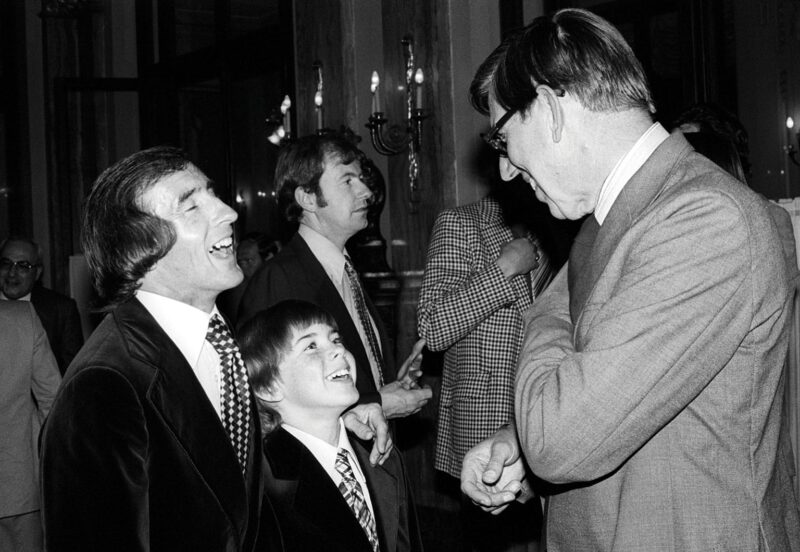
Young Paul sharing a joke with father Jackie and Ken Tyrrell
Motorsport Images
So he stayed home and has spent the intervening years primarily being a father but also responsible for “some financial things”. But he is also the chairman of the Hackney-based Springfield Youth Club that offers a safe haven for local youngsters to go and enjoy themselves. Its connections with motor sport date back to its foundation in 1961 with the help of noted racer Lord Essendon (aka Brian Lewis) and F1 commentator Anthony Marsh. Its first president was Graham Hill, succeeded by Jackie Stewart. Paul took over as executive chairman in 2003. The club looks after about 400 children and is part of the 25,000-strong London Youth umbrella group.
For fun Stewart drives classic cars, including a beautiful Mercedes-Benz 300SL Gullwing and Ferrari 275GTB/4, but he has sold his McLaren F1. “I once found myself with two of the boys on board overtaking four cars in one go with something coming the other way. And while there was plenty of room and no avoidance needed, I found myself thinking ‘What are you doing?’”. He also has his father’s championship-winning Tyrrell-Ford 003.
And then Stewart has to leave. We’ve talked long into the afternoon, the once bustling restaurant is now empty and he needs to prepare for Springfield’s annual prize-giving. He strikes me as a man supremely at ease, proud of what he achieved behind the wheel, prouder still of all that happened at Paul Stewart Racing and Stewart Grand Prix but, ultimately, not someone who chooses to linger in the past.
There will be any number of former drivers who didn’t quite make it to the top who’ll tell you they have no regrets, but none who’ll say it with such conviction. Given everything else he has achieved and survived in his life to date, I have no trouble believing him at all.
